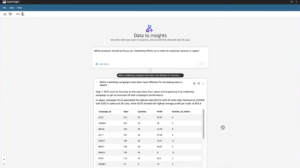
Amazon Web Services (AWS) today added an ability to use natural language to ask an artificial intelligence (AI) agent to create and analyze what-if scenarios within Amazon Q in QuickSight business intelligence (BI) application service.
Q in QuickSight is already integrated with multiple large language models (LLMs) running on the Amazon Bedrock service. The AI agent extends the reach of those models to enable business users or analysts to load, for example, a spreadsheet that can be interactively queried to determine what factors led to increased revenues in a region without having any specialized skills. Alternatively, an AI agent can be used to uncover the potential impact a discount program might have on profitability.
The overall goal is to reduce the time and effort that was previously required to make fact-based decisions regardless of where data is stored, says Jose Kunnackal, director of Amazon QuickSight.

AWS reports that more than 100,000 customers are already making use of the Amazon Q Insight service, including BMW, GoDaddy and the National Football League (NFL). The scenario capability, now generally available, will dramatically reduce the backlog of analytics requests that business analysts are today asked to deliver by either automating previously manual tasks or enabling business users to directly query data, says Kunnackal. Those business analysts can then focus their efforts on more complex analytics, he adds.
“Business analysts today are drowning in a never-ending stream of work,” says Kunnackal.
That approach also provides the added benefit of eliminating the need to manually rekey data, a process that often results in additional errors being introduced. End users can also easily access, modify, extend and reuse previous analyses as needed.
Additionally, end users are shown how each step leading to a recommendation was made, which can be adjusted as end users prefer by changing the steps being employed by the AI agent to better match their own individual experience rather than relying solely on the output of an AI black box, adds Kunnackal.
At the same time, organizations can also ensure that a set of guardrails are in place to ensure that recommendations don’t, for example, violate regulations set by the Securities Exchange Commission (SEC).
Finally, end users can also incorporate the output created by Amazon Q in QuickSight into narratives, also known as stories, within larger presentations.
Longer term, AWS is also exploring how to integrate analytics generated by Amazon Q in QuickSight into automation platforms that would use those outputs to change or optimize specific workflows, Kunnackal says.
It’s not clear how widely AI agents are being incorporated into BI applications but potential impacts could be profound. All too often, businesses are not able to reach fast enough to changing conditions and emerging opportunities simply because the analysis took too long to complete. In fact, it’s not uncommon for the business opportunity that sparked the initial request for analysis to have slipped away before they could be completed.
The challenge now, of course, will be keeping pace with an already hectic rate of potential change that, in the age of AI, is only going to further accelerate.

